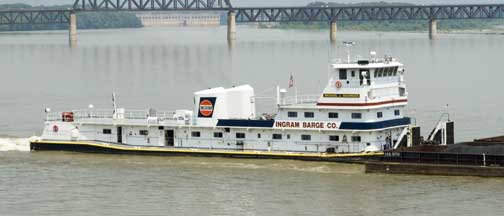The pusher tug or towboat
Since the early days of steam boating on the rivers rows of barges have been pushed ahead of tugs. The western rivers (Mississippi) River used this method of moving bulk cargo. While the first vessels were probably towed astern it was difficult to control the tow. Exactly when the first sternwheeler pushed a barge ahead is not known. The coal trade on the Ohio River needed a method of moving greater tonnages of coal than individual vessels could handle. The method of tying groups of barges together to make a solid tow was developed. A normal steamboat could be used for this with a few changes. Large amounts of coal and other bulk cargos are still moved on the Ohio and other rivers with powerful diesel tugs. Towing knees were built on the bow of the vessels so the towboat could be secured to the tow with wires. Log rafts were also pushed on the Mississippi though they often used a “bowboat” secured across the head of the tow for steering.
While ordinary steamboats were used as towboats a special type of towboat was developed. They had many balanced rudders. From this the modern high powered diesel boat of the day developed.
As other rivers came into use for transportation many boats pushed barges. They were used on the Yukon and Mackenzie Rivers. Large towboats still push tows down the Mackenzie River. Each river has its own characteristics and difficulties. The method of hooking up to tow varied accordingly. Rivers such as the lower Fraser River tow astern because the tows will be heading out into unprotected waters. Small manoeuvrable tugs are often used in the river so they can work in booming grounds, barge tie-ups and mills. On rivers such as the Columbia the barges will come into the river on the towline and if they are going any distance up the river a pusher tug will take over.
Ocean
Barges are pushed ahead on the ocean as well. Due to sea conditions only one barge is pushed ahead. Many of these large barges are built with a notch in the stern. The tug sits in the notch and can work in a swell to some degree. Some of the barges have bow thrusters that can be operated from the tug. Depending on the design of the tug-barge system the tug may have to get out of the notch and get a normal towline on in bad weather. Some barges have been lost if the tug cannot get her line on in time.

Tow boat on Ohio River

The Seaspan Challanger pushing a barge between Vancouver and Naniamo, B.C
|






